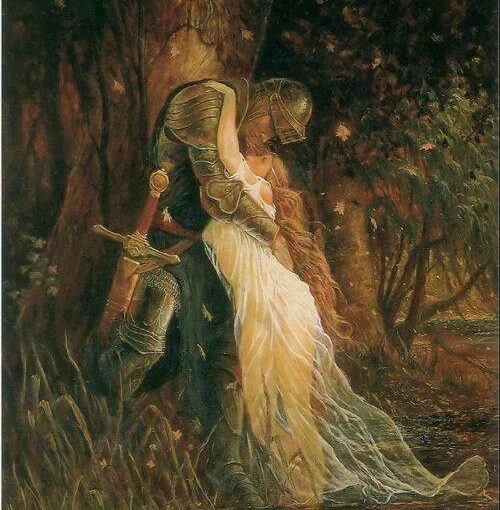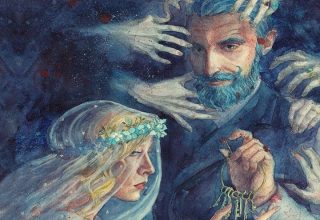Renaud, le tueur de femmes è la versione francese di Lady Isabel and the Elf Knight la ballata archetipo sul Barbablù delle fiabe.
La ballata è un’antica testimonianza di un rituale magico, il sacrificio del Re (che si teneva a Maggio/Primavera in occasione del rinnovamento della Natura).
In seguito è diventata una murder ballad, inquietante per le venature di sadismo evidenti nel cavaliere-predatore sessuale.
Renaud, le tueur de femmes è un monito a tutte le vergini fanciulle di non lasciarsi andare alle pulsioni sessuali incontrollate, perchè invece di trovare un buon marito si finisce malamente in mezzo a una strada.
[English translation]
Renaud, le tueur de femmes is the french version of Lady Isabel and the Elf Knight (Child ballad #4) that defines a very specific theme of popular ballads, the Bluebeard of fairy tales.
This ballad once described a magical ritual-sacrifice of the King (which was held in May / Spring on the occasion of the renewal of Nature). It later became a murder ballad, disturbing for the veins of sadism evident in the knight, as a sexual predator.
Renaud, le tueur de femmes is a warning to all the virgin girls not to let themselves go to uncontrolled sexual urges, because instead of finding a good husband, you end up badly down the road.
Lady Isabel and the Elf Knight
Un’eroina
Le tueur de femmes
Heer Halewijn
Le tueur de femmes tratta di erotismo: Renaud promette un gran piacere alla fanciulla che andrà a cavalcare con lui. L’erotismo ritorna anche nella lunga descrizione della svestizione della fanciulla all’appressarsi del momento in cui verrà affogata.
La storia mi ricorda la ballata “Where The Wild Roses Grow” di Nick Cave in cui si entra nella testa di un serial killer: la donna viene uccisa perchè deve essere punita a causa della sua sessualità selvaggia.
Le tueur de femmes is about eroticism: Renaud promises great pleasure to the girl who will ride with him. Eroticism also returns in the long description of the girl’s undressing when the moment in which she will be drowned approaches.
The story reminds me of Nick Cave’s ballad “Where The Wild Roses Grow“, this ballad enters the head of a serial killer: the woman is killed because she must be punished because of her wild sexuality.
Le tueur de femmes
La trascrizione del testo segue il canto di Jean-Francois Dutertre
il testo di Nick Vanmoryan è mostrato a video ed è una variazione di quello trascritto
I
“Allons, la belle, nous promener (1),
En attendant le déjeuner.
Allons, la belle, allons-y donc:
‘Y a du plaisir nous promenant.”
II
Ils ne furent pas à mi-chemin:
“Renaud, Renaud, que j’ai grand faim!”
“Mangez, la belle, votre main,
Jamais ne mangerez de pain (2).”
III
Ils ne furent pas au bord du bois:
“Renaud, Renaud, que j’ai grand soif!”
“Buvez, la belle, votre sang,
Jamais ne boirez de vin blanc.”
IV
Et quand la belle fut promenée,
Elle demanda-t-à se loger.
“Tu logeras dans le vivier (3),
Ou j’ai sept femmes de noyées.”
V
Et quand ils furent au bord du vivier,
Lui dit de se déshabiller (4):
La belle ôta son blanc jupon
Pour aller voir la mer à fond (5).
VI
“C’est pas à toi, franc chevalier,
De voir ta mie déshabiller.
Mets ton épée dessous tes pieds
Et tourne-toi vers le vivier.”(6)
VII
Elle l’a pris, l’a embrassé (7),
elle l’a jeté dans la rivière (8) :
“Pêche, Renaud, pêche poisson;
Si tu y en prends, en mangerons!”
VIII
Quand le beau galant fut à l’eau,
Il se raccroche à une branche;
La belle tira son grand couteau,
Coupa la branche au ras des flots.
IX
“Voici les clefs de mon château;
La belle, je vous les donnerez.”
“Je m’soucie autant de tes clefs
Que je me soucie de toi.”
X
“La belle, qui vous ramenera
Vers le château de votre père?”
“Le cheval qui nous amena
Bien doucement m’y ramenera.”
XI
“Mais que diront tous vos parents
De vous voir revenir seulette?”
“Je leur dirai la vérité;
Que tu as voulu me noyer!”
I
“Andiamo a cavalcare, o bella
mentre attendiamo per il pasto di mezzodì.
Andiamo, o bella, andiamo dunque;
sarà divertente la nostra cavalcata”
II
Avevano appena fatto mezza strada:
“Reginaldo, sono molto affamata!”
“Mangiatevi le mani, bella dama:
non mangerete mai più il pane”
III
Erano appena sui confini del bosco:
“Reginaldo, sono molto assetata!”
“Bevete il vostro sangue bella dama:
non berrete mai più del chiaretto”
IV
E dopo che la bella galoppò
chiese di andare a casa.
“La tua casa sarà lo stagno,
in cui ho affogato sette mogli”
V
E quando furono sul bordo dello stagno
le disse di spogliarsi.
La bella si tolse il vestito bianco
per andare a vederne il fondo
VI
“Non è da gentiluomini
guardare una dama svestita;
ponete la vostra spada ai vostri piedi
e voltatevi oltre lo stagno”
VII
Lo afferrò e gli mise le braccia al collo
e nella corrente lo gettò
“Andate a pescare Reginaldo
se prenderete qualcosa, lo mangeremo”
VIII
Quando il bel cavaliere fu in acqua
si aggrappò ad un ramo.
La bella prese il suo grande coltello
e tagliò il ramo al pelo dell’acqua.
IX
“Ecco le chiavi del mio castello
le darò a voi, bella dama”
“M’importa delle vostre chiavi
tanto quanto voi!”
X
“Bella dama, chi vi porterà indietro
al castello di vostro padre?”
“Il cavallo che ci ha portato qui
mi riporterà molto docilmente indietro”
XI
“Ma cosa dirà la vostra famiglia
quando ritornerete tutta sola?”
“Dirò loro la verità:
che avete cercato di affogarmi!”
English translation
“Let us go out riding (1), fair maid,
while we wait for the midday meal.
Let us go, fair maid, let us go, then;
there is pleasure in going out riding.”
They were scarcely half way along the road: “Renaud, Renaud, I am very hungry! (2)”
“Eat your own hand, fair maid:
you will never (again) eat bread.”
They were scarcely at the edge of the wood: “Renaud, Renaud, I am very thirsty!”
“Drink your own blood, fair maid;
you will never (again) drink white wine.”
And when the fair maid had taken her ride, she asked to go home.
“Your home shall be in the pond (3),
where I have seven drowned wives.”
And when they were on the edge of the pond, he told her to undress. (4)
The fair maid took off her white petticoat,
to go and see the bottom of the sea (5).
“It’s not for you, bold knight,
to see your sweetheart undress;
put your sword beneath your feet,
and turn towards the pond.”(6)
She has taken hold of him,
put her arms around him (7);
into the river (8) she has thrown him.
“Go fishing, Renaud:
if you catch anything there, we will eat it!”
When the handsome young man was in the water,/ he catches hold of a branch (9).
The fair maid pulled out his big knife
(and) cut off the branch,
level with the waves.
“Here are the keys to my castle;
I shall give them to you, fair maid.”
“I care as much for your keys as I do for you.”
“Fair maid, who will take you back
to your father’s castle?”
“The horse that brought us here
will take me back gently enough.”
“But what will your family say
when you return all alone?”
“I shall tell them the truth:
that you tried to drown me!”
FOOTNOTES
(1) going to ride is evidently a euphemism for sex
(2) contempt and cruelty are the basis of the knight’s sadism
3) “le vivier” is a fish farm, a sort of pond or little llake, in other version, “claire rivière” (clear river)
4) the stanzas of the striptease have been omitted
5) as in other versions there is an incongruity, the pond is now the bottom of the sea
6) in other versions she asks the knight to blindfold himself for not looking at her while she undresses, the erotic game is even more provocative
7) it is a hug to give a kiss, so as to distract the predator
8) other inconsistency [altra incongruenza, ho preferito tradurre con corrente]
9) The branch is most central (tree of life) in other versions of the Eastern countries, (see Heer Halewijn)
NOTE e traduzione italiana Cattia Salto
(1) andare a cavalcare è evidentemente un eufemismo per indicare il sesso
(2) disprezzo e crudeltà sono alla base del sadismo del cavaliere
(3) le vivier è un vivaio per i pesci una sorta di stagno o laghetto, in altre versioni è scritto come “claire rivière” (fiume limpido)
(4) le strofe dello spogliarello sono state omesse
(5) come già in altre versioni c’è un’incongruenza, prima si parlava di uno stagno che adesso è diventato il fondo del mare
(6) in altre versioni la bella chiede al cavaliere di bendarsi gli occhi per non guardarla mentre lei si spoglia, il gioco erotico è ancora più stuzzicante
(7) si tratta di un abbraccio per dare un bacio, in modo da distrarre il predatore
(8) altra incongruenza, ho preferito tradurre con corrente
(9) il ramo è il ricordo sbiadito dell’albero della vita più centrale in altre versioni nei paesi dell’Est, vedasi Heer Halewijn

LINK
https://mascasarvan.wordpress.com/2021/03/08/la-munfreina-la-sposa-ribelle/
https://mudcat.org/thread.cfm?threadid=18292
http://www.nspeak.com/allende/comenius/bamepec/multimedia/essay5.htm


[…] con diverse varianti in molte regioni italiane, dal Nord al Centro, ed è presente pure tra le ballads anglosassoni e nelle chansons francesi. Il tema ricorrente è quello di una giovane sposa che uccide il marito durante il viaggio […]
Grazie per l’approfondimento, ho inserito il link sia nella puntata francese che in quella piemontese